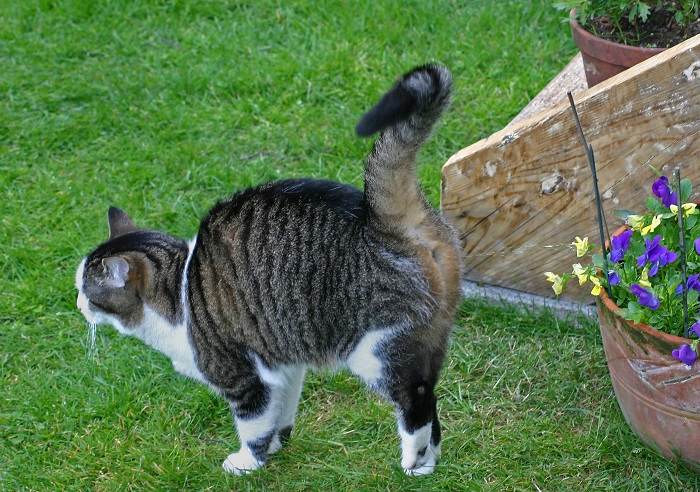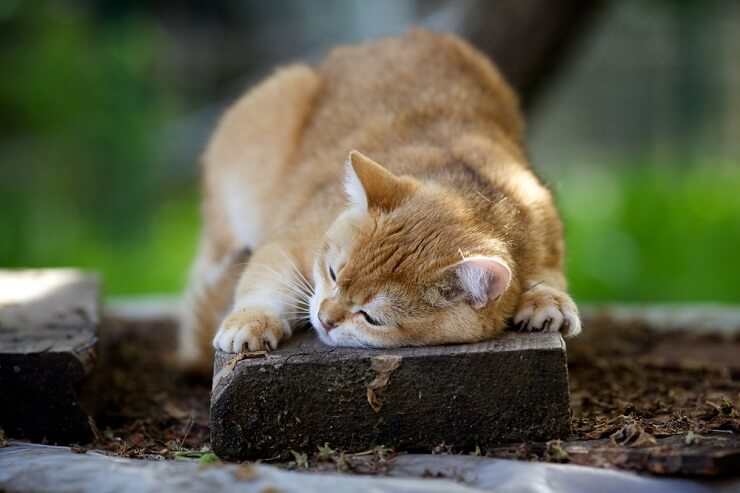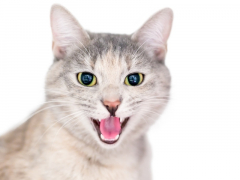
Cat behavior and cat communication are complex topics, and even qualified feline behaviorists are learning new things regularly. When your cat rubs against your legs, lovingly headbutts your forehead, or kneads their paws on your lap, they’re not just showing affection.
As well as being your kitty’s way of saying “I love you,” they’re also releasing their scent from their scent glands. So, where do cats have scent glands? And what is the purpose of these scent-marking behaviors?
Why Do Cats Have Scent Glands?

Cats use their senses of smell to familiarize themselves with new things, including other cats.
It might seem unlikely to you that cats release their scent so frequently because you can’t smell it. However, their scent is made of feline pheromones that their furry friends (and enemies) will be able to smell easily. Cats release pheromones from their scent glands for a few reasons, and it’s not always to communicate with other cats. Let’s find out why.
Territory Marking

When your cat releases their scent by scratching or rubbing against things, peeing, or pooping on them, they’re letting other cats know It’s their territory. It’s their way of saying, “This is mine. Stay away.” They regularly scent-mark their owners. So if you are your feline friend’s favorite human, you can expect them to rub their face against your chin, pad their paws on your lap, or rub against your legs when you walk into the room. It’s not just people that cats claim ownership of, though!
Cats might also mark certain areas of the house, parts of your garden, or, if they’re feeling particularly greedy, even elsewhere in the neighborhood!
Also Read: How Do Cats Mark Their Territory?
Communication

Scent glands play a major part in feline communication.
There’s more to scent marking than just territory, though. Cats can communicate fear, stress, and even happiness through scent. If a cat enters an area where another cat has felt anxious, they may pick up on the scent signal.
Cats can also gain information about another cat’s gender and reproductive status from their scent and recognize whether they’ve met before or if they’re part of their colony. Gaining this information from scents means that cats can give each other physical distance and stay safe if needed.
Reassurance

Cats don’t just use their scent to be passive-aggressive. Their scent can provide comfort and reassurance to cats they are familiar with or bonded with. Similarly, cats often use their scent to reassure themselves and demonstrate that they feel safe and contented in their environment.
For instance, if your cat is relaxing on the sofa with you, you might notice them kneading or bunting (headbutting). This spreads their familiar scent around, filling their senses, so they feel calm and safe.
Read Also: 6 Subtle Signs Your Cat Loves You
Bonding

Pheromone communication is super important for cat bonding, whether it’s with other cats, humans, or other furry family members. Familiar scents and “happy signals” help your cat build relationships. They’ll remember these scents when they come across them in the future, meaning they tend to make friends for life.
Where Are the Scent Glands on Cats?

Cats have scent glands on their paws, cheeks, forehead, lips, flanks, and tail.
Cats release scent in their urine and their anal glands produce scent material that is released into their poop. Since you can’t see a cat’s scent glands, you might not know where they are. So, where else do cats have scent glands?
Their Cheeks

Cats have scent glands on their cheeks, releasing pheromones when they rub their face against things. You might notice your cat rubbing the side of their face against the corners of furniture or walls in the house. This leaves their familiar scent and shows they feel safe in their environment. It also lets other cats know it’s their turf!
Their Forehead

As well as their cheeks, cats have many scent glands on their forehead. Their affectionate headbutting, known as bunting, helps them spread their scent during bonding moments, especially with humans.
Their Lips

Cats release pheromones from glands on their lips. So, the next time your cat gives your ear a little nibble, you know they’re doing it out of love!
Their Flanks

It might be frustrating when your cat weaves in and out of your legs when you’ve just walked through the door. After all, they’re a bit of a tripping hazard. However, your cat is using the scent glands on their body to mark your legs with their scent.
Their Paws

No one wants their cat scratching their brand-new rug, expensive curtains, or antique furniture. However, scratching is a natural and normal behavior for cats. Cats release pheromones from glands in their paws when they scratch, as well as leaving signs of physical destruction. So, if you want your cat to stop scratching particular objects, make sure you have plenty of cat trees, scratch posts, and scratch mats.
Read Also: Why Do Cats Scratch Furniture and Carpets?
Their Tail

You might have spotted your cat spraying urine in the past, hopefully outside rather than in your home. When a cat sprays urine, they don’t just leave their scent in the urine. Their tail has scent glands too. So, they spread even more of their smell in their surroundings.
What Are a Cat’s Anal Glands?

A cat has two anal glands that are situated just inside their rectum. They produce foul-smelling material, which is contained within the anal sacs and released when they pass feces.
This smelly material is another way cats can mark their territory and communicate through scent. Occasionally, the anal glands can become too full or blocked, leading to itchiness, irritation, or infection.
Conclusion

We all know cats like to communicate verbally! But aside from meows and purrs, they also partake in more subtle, silent communication via their scent glands. So, next time you’re wondering why your cat does a particular feline behavior, consider whether they might be spreading their scent.
Frequently Asked Questions
Do cats release a scent when they scratch?
Cats have scent glands in their paw pads, which release pheromones when they scratch. Don't worry, though; it doesn't have to mean cats scratch your furniture or carpets! Just make sure you have plenty of scratching posts, cat trees, and scratch mats so they can flex their claws.
What does it mean when cats headbutt you?
Cats have scent glands on their forehead. When they headbutt people, which is also known as bunting, they release their scent. This shows they feel safe and happy and lets other cats know that you belong to them!
Why do cats rub their face on you?
There is a high concentration of scent glands on a cat’s face, including their cheeks, lips, and forehead. When cats rub their face on you, they release their pheromones to cover you in their scent. This reassures them and keeps them feeling relaxed and secure. It also sends other feline family members the message that you’ve bonded.
Do cats recognize their owner’s scent?
Cats have a very keen sense of smell that is much stronger than a human's. As well as being able to smell their own feline pheromones, they'll also become familiar with their owner's scent. This means they'll be able to recognize their owner easily, even in an unfamiliar environment.







